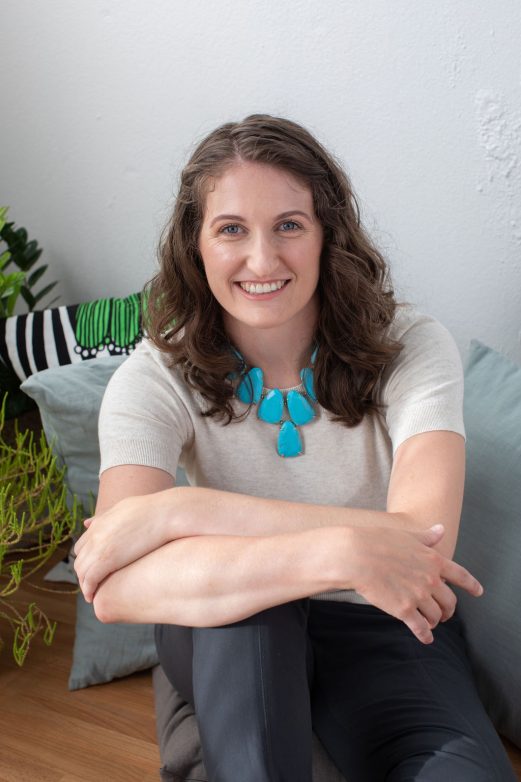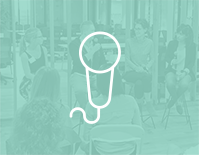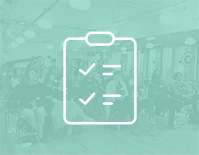Present Yourself Alumni Interview: Emily Parcell
One of the main reasons we wanted to offer our 8-week Present Yourself course as an online program was to make it more accessible to our entire global community, allowing participants to learn on their own time while still having the support and feedback of a live cohort. The online format opened up the possibility of offering expertise from a variety of experts and guest speakers in our community.
With our first Cohort of 2023 underway, we asked alumni for feedback on the topics and structure throughout the course and what they found most useful upon finishing. Here is what one alumni had to say in her own words – meet Emily!

Over the past decade, Emily Parcell led teams to design digital products for DIRECTV, Macy’s, Verizon, and Automation Anywhere before becoming a leadership coach and educator. Driven by her passion to make the workplace more human, she works with clients to apply design skills to leadership challenges, focusing on how process and culture support teams to do their best work.
WTD: Tell us a little bit about you and your speaking background.
Emily: The majority of my professional career has been in leading product design teams. I spent time both in-house and on the agency side. And then, most recently, I have switched over to do leadership coaching and facilitation.
Thinking back about my speaking journey, I remember as a kid, I was pretty fearless. I was in speech class, I did plays or whatever else. Then there was some point in my early professional career, where I just thought, “That’s not me. There are other people who have these big ideas and have opinions and those are speakers. I’m not a speaker.” So it was interesting going through the program and having this cover on myself then realizing, “Oh, yes, that can be me. I do have opinions.”
I’m not sure I’ve done a lot of public speaking per se–I’ve not presented at conferences. But what I’ve been gaining comfort in is doing things like workshops and realizing I did a lot of speaking as a consultant. I have actually done this. Part of it has just been recognizing those parts of my past work–I am a speaker, I do know how to speak and I’m just really starting to embrace that and live with it.
WTD: What led you to Present Yourself and why did you choose to take a course about presenting?
Emily: I’d taken some time away from work. And I was really starting to indulge in all of the different books and ideas that I was interested in. That was the beginning of it. The real catalyst was when I was working with a friend, and we put together a proposal to speak at a conference. And we were just so jazzed about it. For me, it was the first time realizing that I have an opinion about something and there was something I wanted to say.
Spoiler: we didn’t get into the conference. But it was kind of off of that high of realizing that there is stuff that I want to talk to people about, there’s something that I want to share–that drove me to the program. And wanting to do it because I felt ready. I was like, “I’ve got all this stuff now bottled up and I want to figure out how to get it out there.”
WTD: Heading into Present Yourself, what were you most excited about? What made you commit?
Emily: I love classes. Having a structure, having an instructor, having homework–all of that works well for me. So that was part of it. I had this goal–I wanted to start to get out there, I wanted to get my ideas out there–and I felt like having that structure was going to be really good for me.
I was also excited to do it in a community and that completely delivered. I loved the people in my cohort. I met so many fantastic people and heard so many cool ideas from different folks. That was absolutely a draw.
There are a couple of folks who I continue to keep in touch with from my class and I’ve been active in the Women Talk Design community space. The community has this incredible caliber of people. There are a lot of different people who I followed before for their work and then so many of them kept showing up in the Present Yourself Course–Alla Weinberg and Sarah Wachter Boettcher. All these people–I love their ideas, I love the kinds of things they’re thinking about–I didn’t know that they’re a part of this community. I still keep running into people now through the community.
And then, because I had not spoken at conferences but now I had this goal to do that, I wanted structure and advice and something to get me from having the idea to feeling ready to present or put together a proposal.
WTD: What questions did you have going into Present Yourself and how do you feel they were answered?
Emily: I don’t know that I had too many questions. I read the instructions when you give them to me. I felt like whatever materials we were given ahead of time really clearly outlined how much time to expect to block out, what the time outside of class would look like, etc. And so I blocked that on my calendar immediately.
I’m the kind of person where, if the topic is appealing to me, I sign up and go and I’m just excited to get started. I don’t feel like I had a lot of questions or concerns going into it.
[The course] very much delivered. Just yesterday or the day before, I went back through my worksheets, and I was like, “Wait, what’s that structure? How can I think through this talk? What are the different mechanics I should be including?” I’ve continued to reference a lot of the materials. So without having the explicit thought that that would be my goal going into it, that’s such a huge success for me. Now I feel like I have this really robust toolkit that I can go back to time and time again to help keep me focused and make sure I’m being really thorough as I put together a talk or a workshop or even an article. I use it for most things where I’m trying to communicate.
WTD: What part of the course was most useful to you?
Emily: Some of the first materials that just helped us think through our audience and the problems that they’re facing and get really structured about making an outline for the presentation that identifies the problem that you’re solving for–what are the takeaways that you want them to have? What’s your call to action?
I make myself fill out that structure every time I put together one of my newsletters or blog articles. It actually helps me get editing help from other people because I’m like, “Hey, did I actually do this thing I intended to do?” It helps keep me really focused.
The thing I pulled out the other day was the different elements that you could have in a talk. It’s very easy to come up with ideas but I loved the reminder to think about where stories, interactivity, and facts can be woven into it. Using that structure to evaluate what I’ve put together and realize, “Oh, this is kind of fact light–maybe there’s some room for that.” Or, “Is there a place where I could insert some stories here?”
My biggest lightbulb moment in the course was during this broader discussion about where all, you could be going to look for speaking opportunities. Starting to think about it in terms of that–it could be going on podcasts, it could be speaking at meetups–it really broadened the definition of what it meant to get out there and speak for me.
At that point, I knew I hadn’t gotten into the conference. So I came in with this thought that I wanted to speak at conferences, and then that particular opportunity didn’t hit, but I still had all the stuff I wanted to say. So what was so big about that module for me was to realize that there are so many avenues for me to let my ideas out. That helped me broaden my definition of what it is to be a speaker.
WTD: What is the next step you’ll take as a speaker?
Emily: My focus lately has been twofold. Some of it is self promotional–just getting out there more. I’ve been making a lot of videos since I went through the program just to share my ideas or share my business with other people. I’m continuing to get comfortable with that–learning how to write scripts.
The other aspect is actually a service that I offer, which is facilitating workshops for folks. I’ve been figuring out how I want to put that content together and how I’m going to talk through it. While I was working on one of those the other day, I was looking at, like, “Does this have some facts? Do I need some more stories here?” I was able to look back at my toolset in order to make it a lot more well rounded.
I do still want to make it to a conference at some point. I think my baby step next will be to apply for a lightning talk.
WTD: Have you had any exciting wins since taking Present Yourself that you want to celebrate?
Emily: It goes back to the things I mentioned before–it felt like a win to get more comfortable recording and sharing videos. I actually turned my talk from the end of the course into the second video I published. I’ve used that to gain momentum and continue to do that. I can actually look at the computer after I post a video now whereas with the first one, I ran away–complete anxiety, like a vulnerability hangover. And now I’m just putting it out there.
And the second is that I’ve really started to see traction with workshops. I’ve started booking more with regards to having companies bring me in to provide content and facilitation. I’ve also started offering some myself.
I really feel like I’ve been coming into my own as I’m presenting content, or even preparing content to be ready to present. Those are my little wins.
WTD: Who do you feel should take the Present Yourself course? And what advice would you share with someone just starting the course?
Emily: Something that occurred to me while I was in the program was the opportunity for folks who aren’t feeling that comfortable presenting internally. Particularly from coming from a design background, I think a lot about when we have to present to our cross-functional partners.
I don’t think it has anything to do with your level of experience or the amount of time that you’ve been in the industry. It has a lot more to do with your comfort. If you’re feeling a bit uncomfortable sharing, or if you feel like you’re not being as clear as you want to be or your ideas aren’t coming through in the way that you want them to, this would be a great program for you.
You can take that step back and think through the mechanics of communicating–really dissect the process and figure out how to find confidence and see techniques that you could use to communicate more clearly. And then, just get the practice in so that going in front of people can hopefully be a little bit less uncomfortable each time.
[My advice would be to] absolutely show up to the live sessions. I really appreciated the people who were in the course with me and I felt like some of the most special moments were getting thrown into a breakout room with another person, getting to know them and getting to know their topic. And like I’ve mentioned, there are people I’m still in touch with afterwards. I wouldn’t have that extra gift of meeting those people if I hadn’t been showing up to the live sessions and engaging.
My other biggest tip is to save all of the information because you will want to reference it later.
WTD: What makes Present Yourself different from other courses?
Emily: One of the things I appreciated about this course was the variety of presenters who were highlighted throughout each of the different weeks. It emphasized that there’s no one right way to do things and added that element of variety to keep it interesting. I really appreciated that interesting point of comparison.
I am in this other training program right now and I will say something I’ve appreciated about it, which I wasn’t expecting was that it’s majority audio files. So I end up doing a lot of my learning listening while I walk my dog in the morning. And I found that when there were videos for Present Yourself, sometimes I’d put in my headphones and listen while I did dinner prep or something else. I appreciated the ability to not be chained to my computer while taking in some of the content.
Thank you Emily for being a part of Present Yourself and for sharing your experience with us! We can’t wait to see what’s next!
Registration is about to open up for our second Present Yourself Cohort of 2023! If you’ve been thinking about moving your speaking career forward or taking your presenting skills to the next level, sign up now. We also have resources available to ask your employer for reimbursement and advice on how to get the most out of the program.
Have questions? Reach out to us anytime via our website or social and we’ll be happy to answer them!

